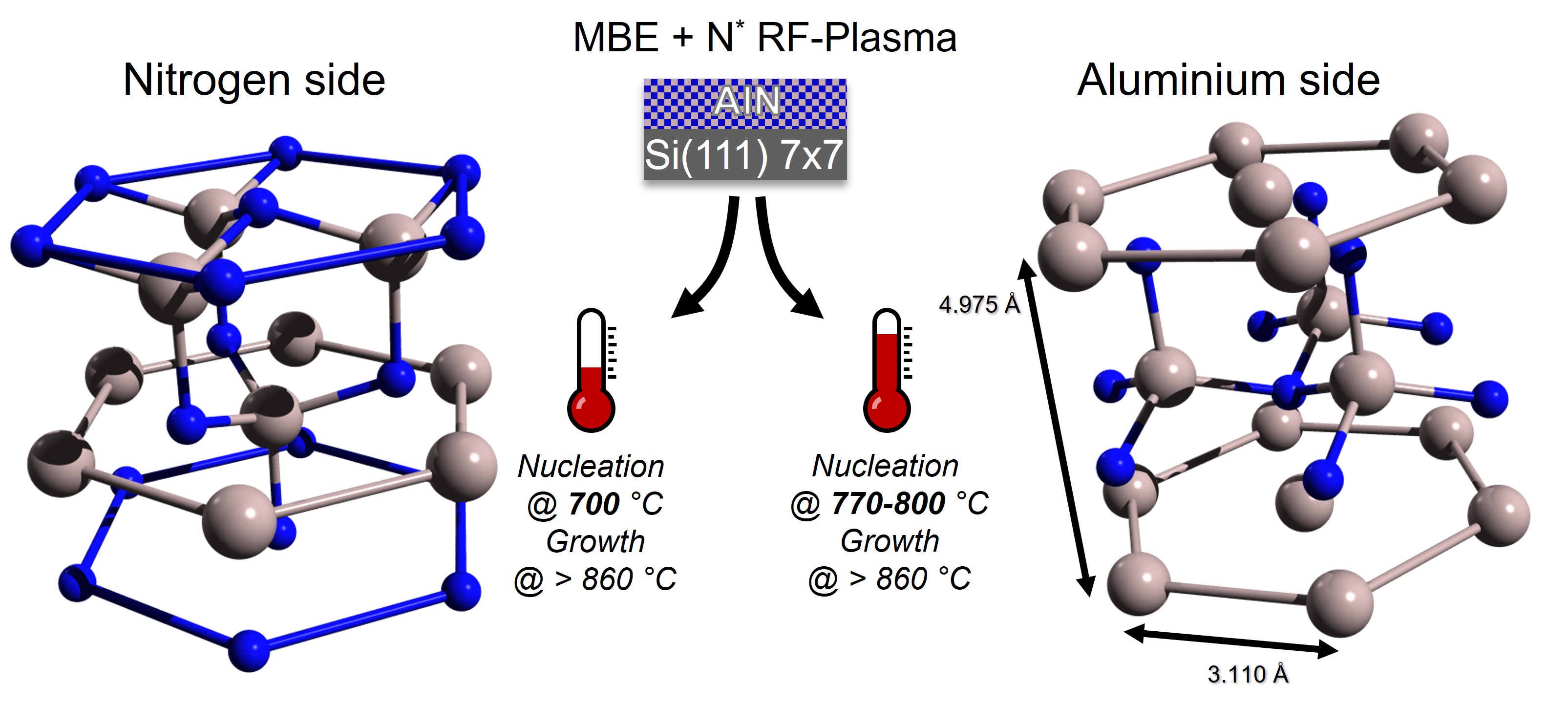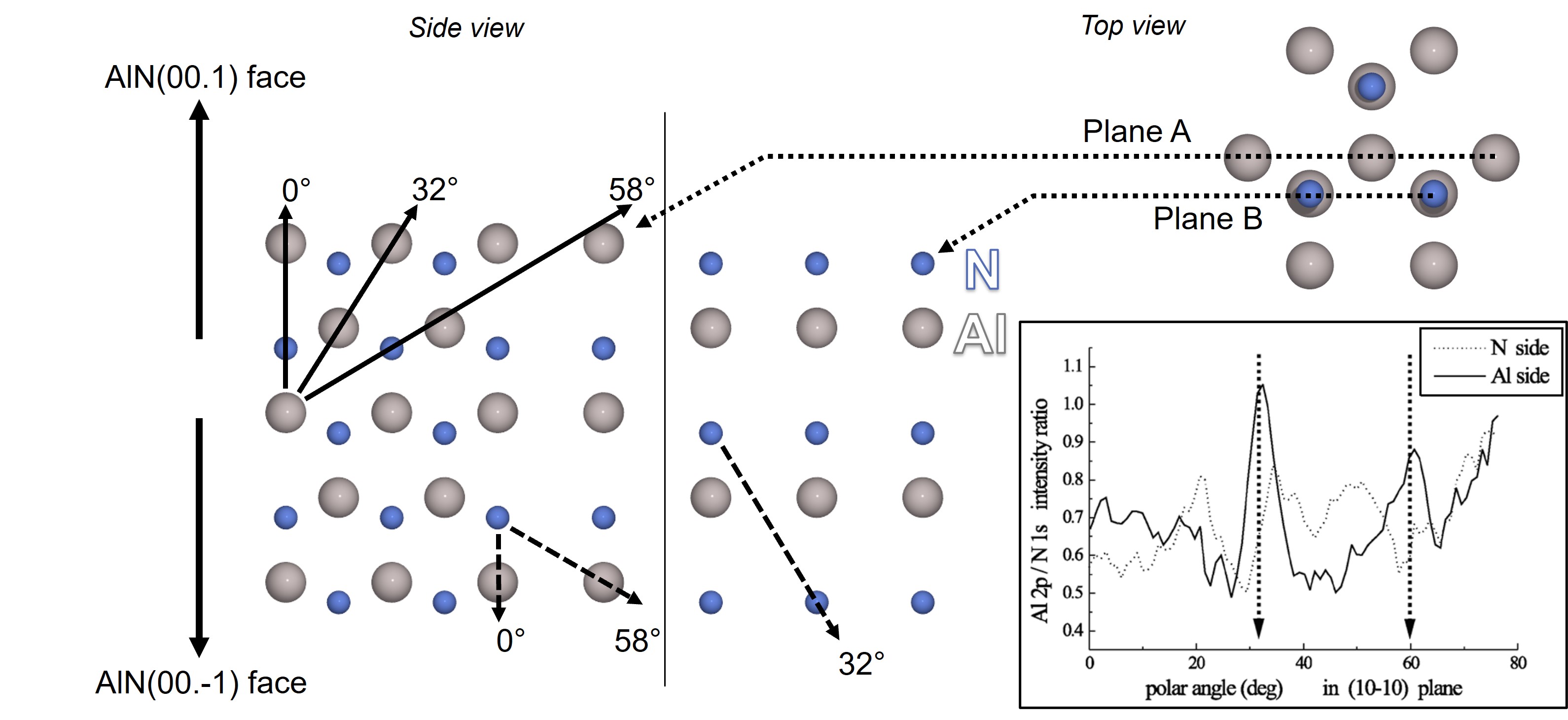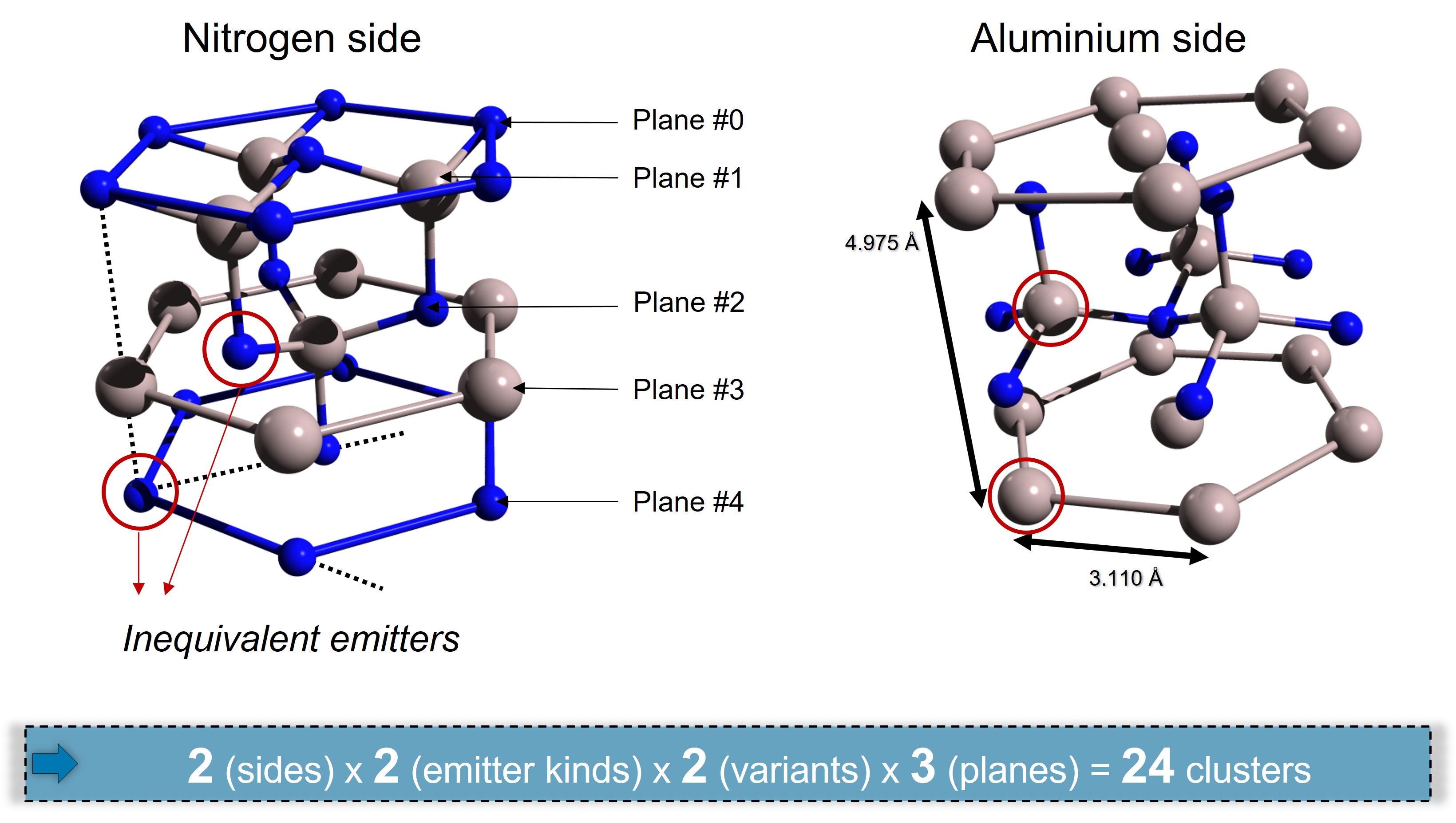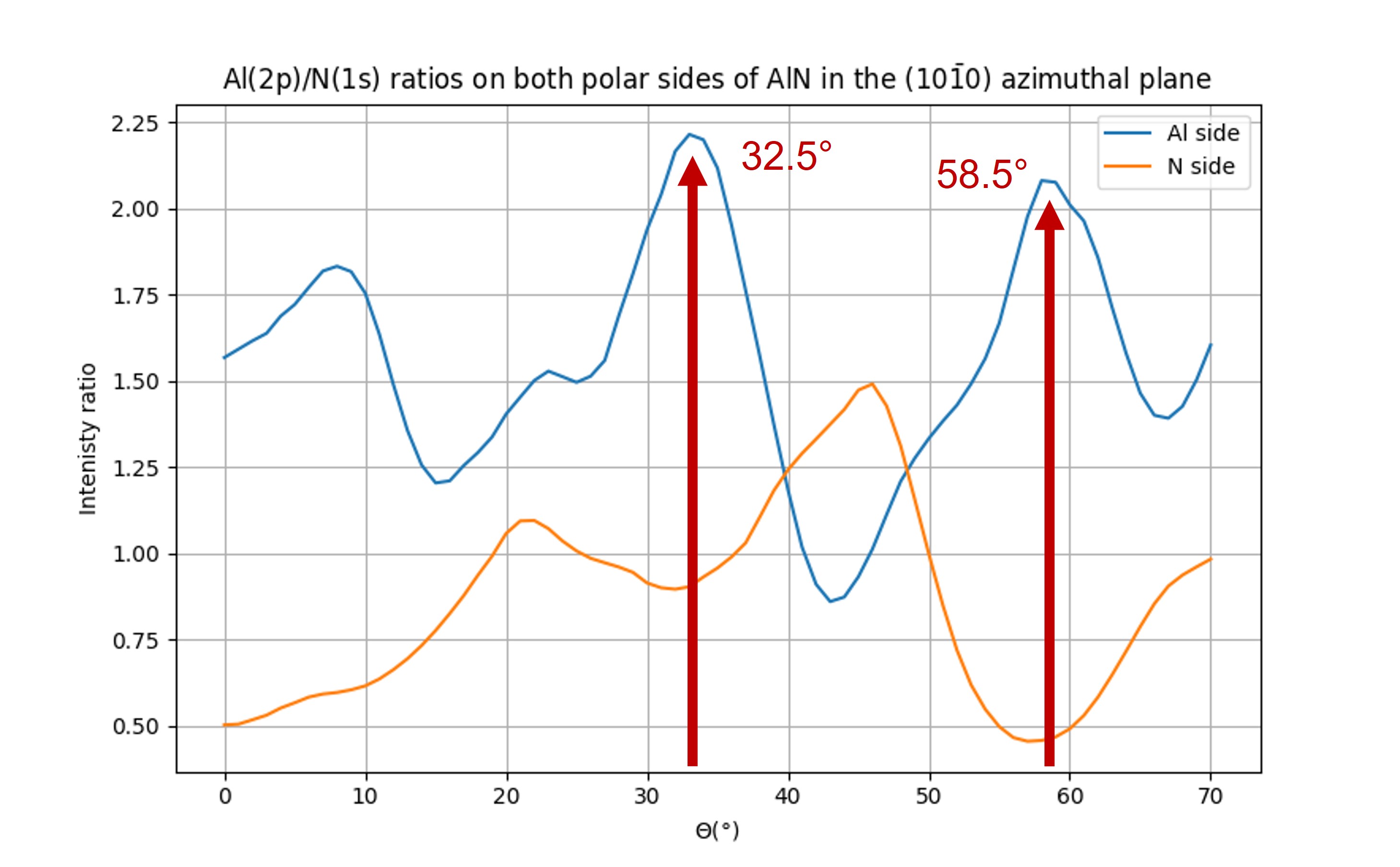Activity 8: Inequivalent emitters and the XPD of a substrate#
XPD can be used to study the adsorption of atoms or molecules on surfaces (Activity 3), or atomic substitutions on surfaces (Activity 2). In this case, modeling is relatively straightforward, since only one emitter atom is involved.
We have seen from previous examples that, for kinetic energies \(\gtrsim\) 500 eV, the use of Rehr-Albers series expansion and scattering path filtering give access to the intensity of deeper emitter atoms (Activity 7). This is the key to computing the total photodiffraction signal of a substrate. As emitted photoelectrons originate from highly localized core levels around the atoms, the total signal corresponds to the (incoherent) sum of the intensities of all inequivalent emitters in the probed volume.
Let’s take a look at how this is done on the following example.
The Aluminium Nitride (AlN) polarity#
In this example, we will compute polar diagrams of an aluminum nitride substrate.
In a work published in 1999, Lebedev et al. demonstrated that Photoelectron diffraction can be used as a non invasive tool to unambiguously state the polarity of an AlN surface. Aluminium nitride cristallizes in an hexagonal cell and the authors experimentally showed that the polarity of the surface can be controlled by the annealing temperature during the growth. Both polarities are sketched in the figure below.
See also
based on this paper from V. Lebedev et al. J. Cryst. Growth. 207(4) p266-72 (1999)

Fig. 19 AlN hexagonal lattice. Left) N polarity with nitrogen terminated surface and AlN4 tetrahedrons pointing downward. Right) Al polarity with aluminium terminated surface and AlN4 tetrahedrons pointing upward#
The AlN(0001) and (00.-1) faces share the same crystallograpphic symmetry and the Al and N atoms have the same geometrical surrounding differing only in the exchange of Al and N atoms (Fig. 20).
It is thus expected that Al(2p) and N(1s) XPD patterns exhibit almost the same features with only small differences due to the contrast between Al and N scattering amplitudes.

Fig. 20 Side views of N- or Al- terminated surfaces showing nearest neighbours main polar crystallographic directions. The inset shows the experimental Al(2p)/N(1s) ratio versus polar angle for both AlN polarities (taken from Lebedev et al.).#
The strongest differences in photoemission intensities suitable for a quick and unambiguous determination of polarity were found in the (10-10) azimuthal plane at 32° and 59° (polar scans in the inset of Fig. 20).
These are the directions of short neighbor distances between the atoms of the same element (32°) and between Al and N atoms (58.5°), respectively.
Using the crystal view in Fig. 19 and assuming that we want to compute Al(2p) and N(1s) intensities for emitters located in 3 different planes to get a substrate signal. How many clusters do we need to build ?

Fig. 21 Number of different clusters to build for Al(2p) and N(1s) in 3 planes#
Download this script and fill in the lines indicated by the comments “FILL HERE”. Run the calculation and check that you are reproducing polar scan of Fig. 20.

Fig. 22 Polar scans in the (10-10) azimuthal plane of AlN for Al polarity (left) and N polarity (right)#

Fig. 23 Al(2p)/N(1s) intensity ratio for both polarities#
As can be seen in Fig. 23, the peaks at 32° and 58.5° are well reproduced by the calculation for an Al polarity. Some discreapancies arise between the experimental work and this simulation especially for large polar angles. This may be due to a too small cluster in diameter for the deeper emitters.
1#!/usr/bin/env python
2# coding: utf8
3
4from ase.build import bulk
5import numpy as np
6from msspec.calculator import MSSPEC, XRaySource
7from msspec.utils import hemispherical_cluster, get_atom_index
8
9def create_clusters(nplanes=6):
10 def get_AlN_tags_planes(side, emitter):
11 AlN = bulk('AlN', crystalstructure='wurtzite', a=3.11, c=4.975)
12 [atom.set('tag', i) for i, atom in enumerate(AlN)]
13 if side == 'Al':
14 AlN.rotate([0,0,1],[0,0,-1])
15 Al_planes = range(0, nplanes, 2)
16 N_planes = range(1, nplanes, 2)
17 else:
18 N_planes = range(0, nplanes, 2)
19 Al_planes = range(1, nplanes, 2)
20 if emitter == 'Al':
21 tags = [0, 2]
22 planes = Al_planes
23 else:
24 tags = [1, 3]
25 planes = N_planes
26 return AlN, tags, planes
27
28 clusters = []
29 for side in ('Al', 'N'):
30 for emitter in ('Al', 'N'):
31 AlN, tags, planes = get_AlN_tags_planes(side, emitter)
32 for emitter_tag in tags:
33 for emitter_plane in planes:
34 cluster = hemispherical_cluster(AlN,
35 emitter_tag=emitter_tag,
36 emitter_plane=emitter_plane,
37 planes=emitter_plane+2)
38 cluster.absorber = get_atom_index(cluster, 0, 0, 0)
39 cluster.info.update({
40 'emitter_plane': emitter_plane,
41 'emitter_tag' : emitter_tag,
42 'emitter' : emitter,
43 'side' : side,
44 })
45 clusters.append(cluster)
46 print("Added cluster {}-side, emitter {}(tag {:d}) in "
47 "plane #{:d}".format(side, emitter, emitter_tag,
48 emitter_plane))
49 return clusters
50
51
52def compute(clusters, theta=np.arange(-20., 80., 1.), phi=0.):
53 data = None
54 for ic, cluster in enumerate(clusters):
55 # Retrieve info from cluster object
56 side = cluster.info['side']
57 emitter = cluster.info['emitter']
58 plane = cluster.info['emitter_plane']
59 tag = cluster.info['emitter_tag']
60
61 # Set the level and the kinetic energy
62 if emitter == 'Al':
63 level = '2p'
64 ke = 1407.
65 elif emitter == 'N':
66 level = '1s'
67 ke = 1083.
68
69 calc = MSSPEC(spectroscopy='PED', algorithm='expansion')
70
71 calc.source_parameters.energy = XRaySource.AL_KALPHA
72 calc.source_parameters.theta = -35
73
74 calc.detector_parameters.angular_acceptance = 4.
75 calc.detector_parameters.average_sampling = 'medium'
76
77 calc.calculation_parameters.scattering_order = max(1, min(4, plane))
78 calc.calculation_parameters.path_filtering = 'forward_scattering'
79 calc.calculation_parameters.off_cone_events = 1
80 [a.set('forward_angle', 30.) for a in cluster]
81
82 calc.set_atoms(cluster)
83
84 data = calc.get_theta_scan(level=level, theta=theta, phi=phi,
85 kinetic_energy=ke, data=data)
86 dset = data[-1]
87 dset.title = "\'{}\' side - {}({}) tag #{:d}, plane #{:d}".format(
88 side, emitter, level, tag, plane)
89
90 return data
91
92
93def analysis(data):
94 tmp_data = {}
95 for dset in data:
96 info = dset.get_cluster().info
97 side = info['side']
98 emitter = info['emitter']
99 try:
100 key = '{}_{}'.format(side, emitter)
101 tmp_data[key] += dset.cross_section
102 except KeyError:
103 tmp_data[key] = dset.cross_section.copy()
104
105 tmp_data['theta'] = dset.theta.copy()
106 tmp_data['Al_side'] = tmp_data['Al_Al'] / tmp_data['Al_N']
107 tmp_data['N_side'] = tmp_data['N_Al'] / tmp_data['N_N']
108
109 # now add all columns
110 substrate_dset = data.add_dset('Total substrate signal')
111 substrate_dset.add_columns(**tmp_data)
112
113 view = substrate_dset.add_view('Ratios',
114 title=r'Al(2p)/N(1s) ratios on both polar '
115 r'sides of AlN in the (10$\bar{1}$0) '
116 r'azimuthal plane',
117 xlabel=r'$\Theta (\degree$)',
118 ylabel='Intenisty ratio')
119 view.select('theta', 'Al_side', legend='Al side',
120 where="theta >= 0 and theta <=70")
121 view.select('theta', 'N_side', legend='N side',
122 where="theta >= 0 and theta <=70")
123 view.set_plot_options(autoscale=True)
124
125 return data
126
127
128clusters = create_clusters()
129for cluster in clusters:
130 cluster.edit()
131exit()
132data = compute(clusters)
133data = analysis(data)
134data.view()
135
